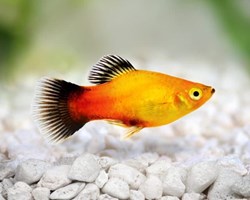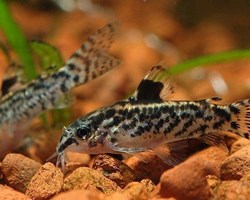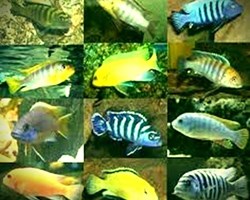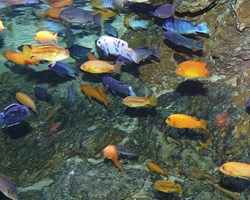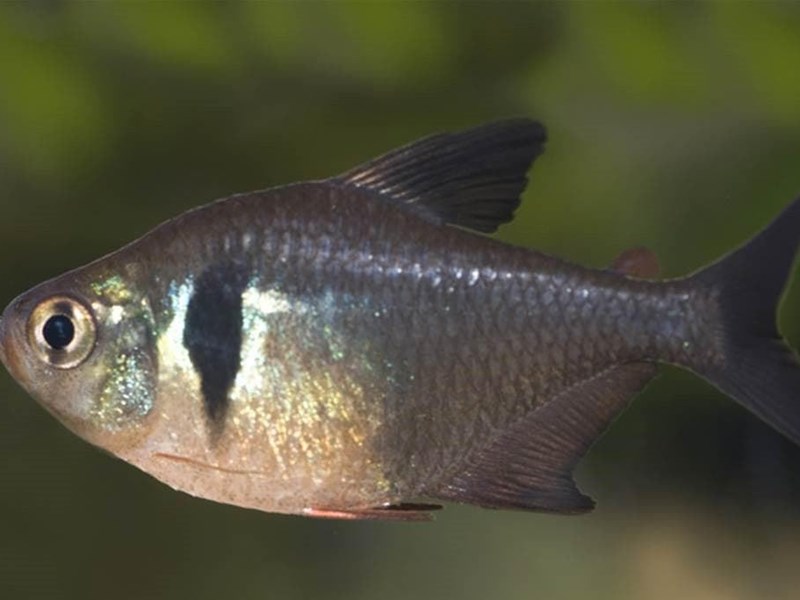
HOW IS THE BLACK AND RED GHOST TETRA FISH:
The scientific name is Hyphessobrycon megalopterus (CH Eigenmann, 1915).
It is included in the order Characiformes, family Characidae, and in the genus Hyphessobrycon.
In its genus we find more than 100 species.
It is one of the most typical of the South American characins that it shares with other popular fish such as the serpae tetra, bleeding heart, white fin roxy, the Colombian tetra or the red ghost tetra (H. sweglesi).
It is one of the iconic species both for the community aquarium and for biotope aquariums, whether they are from the Amazon or from other South American rivers.
Its ability not to lose all coloration in commercial display aquariums guarantees its success and popularity.
Black ghost tetras are South American tetras, characterized by a very splendid dark coloration. Especially with regard to the often much more colorful coloration of Bolivian tetras, this dark coloration turns out to be a unique selling point.
The natural range of the black ghost tetra, which originates from South America, is made up of the catchment areas of the Guaporé River and the Paraguay River.
He is happy with his individual retreat and with the floating plants as well as the plants on the edge of the aquarium.
The black ghost tetra is a free generator.
Red Ghost Tetra: A very active species suitable for the South American biotope aquarium.
Its coloring is very simple but, at the same time, very striking.
That of the young specimens is very pale red, on the contrary, the adults have a very intense red hue. On it there are three black spots, two behind the opercula and another one on the dorsal fin.
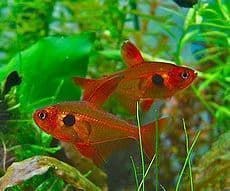
Red ghost tetra fish are a type of characin that can measure up to four centimeters in length, with a large head and a very large mouth with a lower jaw slightly more developed than the upper jaw.
It should be noted that male ghost tetras have a slightly longer and thinner dorsal fin than females, who, in addition to having a slightly more reddish color with white tones, are smaller and thinner.
These fish are characterized by having circular eyes, with a wide iris and a large, dark pupil.
Their body tends to be very tall, but at the same time laterally compressed, they also have a quite beautiful coloration, of a reddish-brown tone, with slightly purple areas that contrast with the lower part of their stomach, which is silver.
Similarly, its fins, both dorsal and anal, can develop in a surprising way, the dorsal being reddish with a black terminal spot.
But there are a few things to keep in mind when keeping small features in the aquarium.
Typical rhomboid characin shape, more vertically thickened at mid-body. It reaches a maximum size of 4 – 4.5 cm.
The base color of the body is a transparent grayish.
The main feature is found in the color black.
On the gill operculum they present a black spot that has edges with flashes of blue.
All fins are black in males.
Females have red adipose, ventral and anal fins.
The color of the body of the females in its anterior part has a slight reddish tone if we compare it with that of the males.
The fins, mainly in males, are very pronounced in relation to the size of the fish.
The dorsal fin in males is especially elongated, while the anal fin is wide and curved descending vertically.
Another difference will be observed in the length of the fins of the males, especially in the dorsal and anal fins, which are longer than the fins of the females.
Sexual dimorphism: Very marked.
The main difference will be seen in the color of the fins.
In males the fins are black, while females have red adipose, anal and ventral fins, they can also show a reddish-silver tone on the front part of the body compared to the simply silver of males.
The color of males is generally more intense.
Females are larger than males and hold hierarchical supremacy.
It has a laterally compressed rhomboid body. The development of the dorsal and anal fins is striking, much greater in males. Its morphological sign of identity is the black spot behind the gill semi-bordered on both sides by a white or metallic blue iridescence.
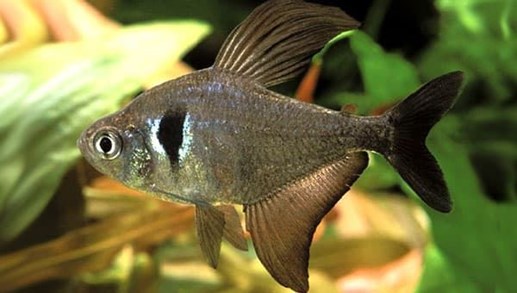
THE BEST CARE OF THE AQUARIUM:
Temperature: 23ºC – 28ºC
pH: 6.0 – 7.5
Hardness: 2-20ºdGH. Always better in soft water, in hard water they tend to lose color.
Active and peaceful species ideal for a wide range of community aquariums.
It only reaches 4 – 4.5 cm, so a large tank is not necessary for its maintenance, in a 60 cm long aquarium a small group of black ghosts can live.
It is a South American school characin, so it is recommended to always introduce groups of a minimum of 6-8 specimens, and as many as desired when the volume of water in the aquarium allows it.
It is a very swimming species that gains security if it is installed in a generously planted aquarium and with some decorative objects.
Like many other Tetras, at nightfall it turns off its activity and illuminates its color until it is almost translucent in order to camouflage itself and go unnoticed.
It is a perfect species for aquariums with soft and acidic waters such as Amazonas, Paraná or other similar ones.
The maintenance of the black ghost tetra in the aquarium is not very difficult. The animals are relatively undemanding compared to other South American species. So if you focus a bit on the animals when planning the tank and consider the following tips, you will be able to keep the fish permanently with no problems.
The black tetra is particularly comfortable in dark pools and welcomes dense border plantings and floating plants. But also the introduction of decorations, such as roots or stones, are gratefully accepted by the black ghost tetras as a hiding place and shelter. However, these are also used for enclosure formation. The animals mark small territories in the mating season and defend them from other animals of the same species. They puff themselves up to impress the other males (and females).
Substrate and decoration in the aquarium should be kept as dark as possible, since it is in its natural range. In addition, too strong lighting (or LED with variable illuminance) should not be installed.
The preferred water parameters of the black ghost tetra can often be achieved without problems even with German tap water. Therefore, the temperature of the water should be between 22 ° C and 26 ° C. A pH value between 6.0 and 7.5 is more tolerable for the animals, so the water should have a total hardness of 2 to 15 ° dGH. and should not exceed it.
Like other species of Tetras, it can increase its aggressiveness against other similar species, leaving traces of its bites on the fins, when it is kept at high temperatures. The most suitable temperature range would be between 24 and 26ºC without reaching the extreme of exceeding 28.
To prevent the ghost tetra fish from catching any disease, it is important to maintain a clean aquarium, the water should be changed at least once a week to prevent the formation of pests or harmful bacteria. It is also important to have a good filter to keep the water always crystal clear and you can opt for natural or artificial floating elements to place inside the aquarium but that are not heavy and pointed.
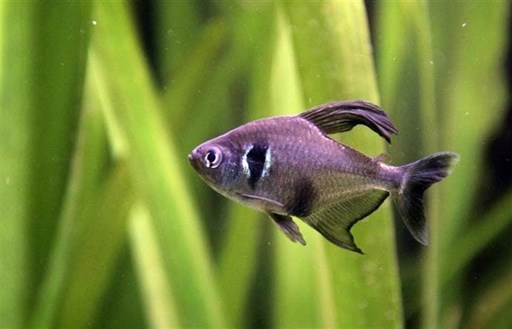
THE BEST NUTRITION FOR YOUR PHANTOM TETRA:
A black ghost tetra lives on small flaky foods in combination with live mosquito larvae and similar animals.
If necessary, the animals can also be fed flakes or dry food.
It is important to feed them a varied diet of live and frozen foods.
These specimens come from the family of omnivores, so they do not represent any problem when giving them any food.
It is not a bad idea to have a varied diet, one day you can combine frozen food with flakes and freeze-dried so that its color always remains strong and robust.
The ideal is to feed them twice a day in small amounts so that it is not wasted.
This species needs a lot of short live food such as: rubifex, vinegar fly larvae, artemia nauplius and small strained daphnia which meet all its needs.
Although there are also special products on the market that come with a sufficient vitamin source for its correct development.
At Glu Glu Pet we recommend the following products:
THE REPRODUCTION OF THE GHOST FISH IN CAPTIVITY IS SIMPLE:
Follow the same instructions as for other family members:
- a slightly acid pH 5.5-6.5, the temperature around 27ºC, ºdGH between 1 and 5, in a separate tank previously prepared with abundant vegetation.
- The black phantom tetra, Hyphessobrycon megalopterus (Eigenmann, 1915), is one of the iconic species both for the community aquarium and for biotope aquariums, whether they are from the Amazon or from other South American rivers.
- This small Characin, between 3.5 and 4.5 cm, is native to South America. Upper Amazon Basin and Paraguay River.
- Like other species of Tetras, it can increase its aggressiveness against other similar species, leaving traces of its bites on the fins, when it is kept at high temperatures.
- The most suitable temperature range would be between 24 and 26ºC without reaching the extreme of exceeding 28.
- Its reproduction is totally viable in an aquarium, but if you want to be successful with the larvae, you will have to set up a dedicated aquarium of about 40 liters with a bottom of marbles and some fine-leaved plants attached to the substrate with some mesh.
- A simple compressor will serve as a filtration system to aerate the water.
It is advisable to introduce the couple, who may have been related in the community aquarium, after a few days apart.
During this stage we will feed generously with frozen food until we confirm the presence of eggs by the ventral fattening of the female.
The breeding tank water should be slightly acidic and moderately soft. Preferably without lighting, only with indirect light.
The male will chase the female in a kind of courtship.
The setting is made at dawn after which it is convenient to remove the couple.
After removing them we must cover the breeding aquarium to darken it.
After four days we will have the first hatched larvae that after consuming the yolk sac will be ready for free swimming.
At this time they accept commercial compounds for larvae, generally in liquid form, and in a short time microworms. It is advisable to take care of the presence of nitrogenous compounds so as not to suffer massive losses.
It is also necessary to have a good filter so that the water remains clean and fresh. From there it is only a matter of worrying that they are happy and comfortable in their habitat.
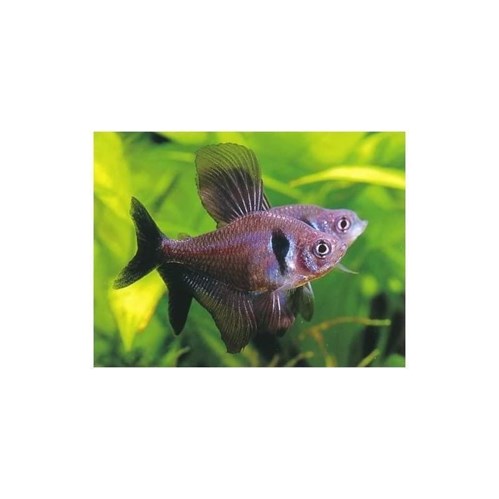
FOR YOUR BEST CARE YOU MUST KNOW WHAT IS YOUR BEHAVIOR AND COMPATIBILITY:
They are ideal fish for the community aquarium.
Active and gregarious, it is always recommended to keep them in schools.
They can even associate in a school with other species of similar tetras.
Very peaceful they will not pose problems with other fish.
Their ideal companions are other South American tetras and corydoras, although they are also successfully combined with rasboras, guppies, mollys, platys, and on some occasions gouramis and dwarf cichlids.
It is a group swimmer that will be seen in the middle of the aquarium.
They like a decoration with plants and trunks simulating an Amazonian biotope.
It is a suitable fish for beginners that will combine perfectly with many species.
For the best maintenance and display of the black ghosts, they should be provided with an aquarium with dim lighting, with dense vegetation that includes floating plants, trunks, roots and a variety of hiding places.
They prefer a slightly acidic to neutral pH, soft water, and temperatures between 23º and 28º C.
Its ability to adapt to the aquarium is extraordinary as long as we do it in groups of no less than a dozen individuals.
It is common for small groups to form schools with other similar species such as Hemigrammus, Copella or other Tetras.
Black ghost tetras are particularly social animals.
In order to live their social behavior intensely, the size of the group is crucial.
Especially in large schools, as can be done in a 180 liter or 350 liter aquarium, they are characterized by a particularly distinctive swarming behavior.
At Glu Glu Pet we recommend keeping animals only in larger tanks with a rim length of one meter or more.
Thanks to its calm and peaceful nature, the Black Ghost Tetra can easily socialize with other species.
Especially the South American dwarf cichlids, such as the butterfly cichlids, are particularly suitable for breeding, especially since the animals were also found together in the wild.
Large animals of 4.5-5 centimeters can also be socialized with larger ornamental fish, such as discus or angelfish, without major problems if they are used in front of their larger companions.
It is important that the territory of the animals is respected.
THE DISEASES OF THE PHANTOM TETRA FISH:
Ghost tetra fish do not take advantage of the food that falls to the bottom of the aquarium, so you must try to ensure that too much does not fall into the water, as this can affect the quality of oxygenation.
The worst of the case is that there may be constant health problems that directly attack the immune system of the fish, causing them to lower their defenses.
It is important to change the water at least once a week to avoid the creation of pests or bacteria, this can directly penetrate the food that the ghost tetra fish then ingests, causing an infection in the body.
The ghost tetra fish is sensitive to the protozoan, a disease that develops in the body causing damage mainly to the muscles.
As a result of this condition, some disproportions may arise in the spine, if so, the first thing to do is remove the sick fish from the aquarium and place them elsewhere to prevent it from infecting others.

